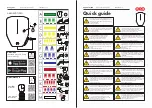
CAUTION:
THE RETURN CAPACITY WHEN CHARGING THE BATTERY IS NOT 1-TO-1. ENSURE THAT BATTERY IS ALLOWED TO
CHARGE FOR A GREATER PERIOD OF TIME THAN IT WAS USED (IF NOT COMPLETING A FULL CHARGE). FOR MAXIUMUM BATTERY
LIFE, FULLY RECHARGE BATTERY (LED WILL APPEAR SOLID GREEN) AT LEAST TWICE PER WEEK. FAILURE TO DO SO MAY RESULT
IN SHORTER RUNTIMES AND PREMATURE BATTERY FAILURE.
WARNING:
ONLY USE BATTERY/CHARGER CONFIGURATIONS SPECIFICALLY APPROVED BY NFE. USE OF A DIFFERENT OR
INCORRECT CONFIGURATION HAS A HIGH RISK OF LEADING TO FIRE, PREMATURE BATTERY FAILURE, DAMAGE TO MACHINE, AND/
OR BODILY INJURY.
CAUTION - PRECAUTIONS:
• REMOVE PERSONAL METAL ITEMS SUCH AS BRACELETS, RINGS, NECKLACES AND WATCHES WHEN WORKING WITH BATTERIES.
A BATTERY CAN PRODUCE A SHORT CIRCUIT CURRENT SUFFICIENT ENOUGH TO WELD METAL OBJECTS, CAUSING SEVERE BURNS.
• NEVER SMOKE OR ALLOW A SPARK OR FLAME IN THE VICINITY OF THE BATTERIES. CAUTION MUST BE TAKEN TO REDUCE THE
RISK OF DROPPING METAL TOOLS ONTO THE BATTERY. A SPARK OR SHORT CIRCUIT MAY RESULT IN AN EXPLOSIION.
• USE OF ANY ATTACHMENT IS NOT RECOMMENDED AND MAY RESULT IN RISK OF PERSONAL INJURY, ELECTRICAL SHOCK OR FIRE.
Safety
3
Charger Operation
Ensure proper use of charger.
• Once connected and plugged into AC power, the LED will
indicate whether or not it is charging.
Batteries and Chargers
Use caution; risk of explosive gases.
Batteries generate explosive gases during normal operation. Do
not use near fuels, grain, dust, solvents, or other flammables;
never smoke near the machine, battery, or charger.
Inspect battery and charger regularly.
Disconnect charger from wall outlet before operating. Machine
should be off before connecting to a power source. Periodically
inspect batteries, cables, charger, and all plug connections. Be
extremely cautious when working with batteries. Do not open or
tamper with batteries; doing so could cause electrical shock.
CHARGER SAFETY GUIDELINES
CAUTION:
KEEP EXPOSURE OF CHARGER TO MOISTURE TO A MINIMUM.
WARNING:
BE CAUTIOUS WHEN WORKING WITH BATTERY. IF ELECTROLYTIC ACID GETS IN THE EYES, IMMEDIATELY FLUSH OUT
WITH COLD, FRESH WATER FOR AT LEAST 10 MINUTES AND GET MEDICAL HELP.
CAUTION:
USE OF DAMAGED OR IMPROPER EXTENSION CORD COULD RESULT IN RISK OF FIRE OR ELECTRICAL SHOCK. IF AN
EXTENSION CORD MUST BE USED, MAKE SURE:
• THAT THE CONFIGURATION OF THE EXTENSION CORD PLUG AND BATTERY CHARGER PLUG ARE IDENTICAL AND IN GOOD
OPERATIING CONDITION.
• THAT THE EXTENSION CORD IS PROPERLY WIRED AND IN GOOD CONDITION.
• THAT THE EXTENSION CORD WIRE SIZE IS AT LEAST 12 GAUGE UNLESS GREATER THAN 25 FEET. IF USING AN EXTENSION CORD
GREATER THAN 25 FEET, IT MUST BE A MINIMUM 10-GAUGE CORD.
DO NOT USE AN EXTENSION CORD GREATER THAN 50 FEET!
•
Only use charger on branch circuits protected by a circuit
breaker or fuse that can carry the power of the charger.
•
Do not use charger if it shows signs of physical stress, or if
DC output leads or connector feel hot when used.
•
Do not disconnect DC output clamps or connector from bat
-
teries while charger is on. This could cause an explosion.
•
Failure to unplug AC power before moving equipment will
damage cords, plugs, and receptacles.
•
Charger is not water proof, only resistant, and cannot with
-
stand immersion, continuous exposure, or heavy rain.
•
Chargers are equipped with a grounding plug and must be
plugged into a grounded outlet.
Note:
Leaving the charger plugged in does not harm the battery
and is preferred to leaving the battery in a state of discharge.
Summary of Contents for 404062
Page 1: ...Read Manual Before Operating 404076 Rev A 404062 48 VOLT CHARGER INSTRUCTION MANUAL...
Page 2: ......
Page 6: ......
Page 7: ......


























